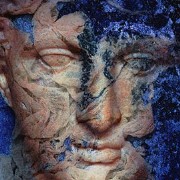01 July 2016
 Former lead singer of the hugely influential British band Ultravox, electronic music pioneer and visual artist, John Foxx, is bringing his exhibition Europe After The Rain to Australia for the first time.
Former lead singer of the hugely influential British band Ultravox, electronic music pioneer and visual artist, John Foxx, is bringing his exhibition Europe After The Rain to Australia for the first time.
The exhibition will be on display from 13 July to 5 August in Adelaide at the Kerry Packer Civic Gallery and will coincide with a public in-conversation event in which Foxx will discuss his career with UniSA’s Director of the Hawke EU Centre, Professor Anthony Elliott.
Whilst many know of Foxx from his forays in electronics (he has worked with, among others, Brian Eno, Harold Budd and Gary Numan), less know of his artistic endeavours. Working as a graphic artist (using his real name of Dennis Leigh), he has produced some of the finest book covers of recent decades – including for such writers as Salman Rushdie, Anthony Burgess and Jeanette Winterson.
In Europe After The Rain, which mixes classical imagery with modern found objects and architecture, Foxx combines images from different photographs, which were taken on tours across Britain and Europe over the past three decades.
Foxx recalls, how a happy accident ultimately led to the curation of his visually stunning and unique portrayal of the continent.
”I was wondering what to do with the photographs I'd taken and actually thought I ought to throw most of them away, when I accidentally picked up two slides together and saw something new. The layering gave them another unexpected dimension. Everything became richer and more resonant,” Foxx says.
“So I began to combine and recopy the resulting images - and arrived at a new way of working. This was all just before digital photography began.
“Later, around 1983, a friend gave me access to the first digital computer imaging system in Soho, London. I believe I was among the very first to compose images in this way.
“What I was attempting to do was to combine classical imagery with modern found objects and architecture. This seems to carry a number of emotional and intellectual charges, from pure nostalgia and a sense of loss, to a rediscovery of overlooked, half-forgotten things that still have great potency and relevance, a sort of undercurrent that still affects us in various ways, but is barely recognised.
“It also allowed a visual continuity with the origins of our language, art, and civilisation - all of which came from Europe and the interface between France, Rome, Greece and the Middle East. I've always been interested in this, and instinctively drawn to classical antiquity. Fragmented statuary and broken objects seem especially poignant and carry many rich associations and meanings.
“A fragment indicates the previous presence of a whole, evidence of a tantalisingly lost time - beyond that also lies a set of social, political, economic, artistic and philosophical structures that supported its making and also the alterations in these that eventually caused it to be discarded.
“Reconnecting with some of these lost avenues has always seemed very important to me. They are literally three dimensional memories, half buried, waiting for rediscovery.
Professor Anthony Elliott describes Foxx’s work as a visual artist as “equally fascinating” as that of his musical talent.
“Foxx’s artworks have been celebrated in Europe: his art was showcased at the Institute of Contemporary Art in London some years ago, and his magisterial Cathedral Oceans was performed inside the Great Hall at Durham Castle, England,” Professor Elliott says.
“But this will be the first time that Foxx’s artworks are shown in Australia – and the Hawke EU Centre at UniSA is exceptionally pleased to be bringing him here to Adelaide”.
Contact details:
Professor Anthony Elliott, Executive Director, Hawke EU Centre email: Anthony.Elliott@unisa.edu.au
Media contact: Will Venn mobile: 0401 366 054 email: will.venn@unisa.edu.au



